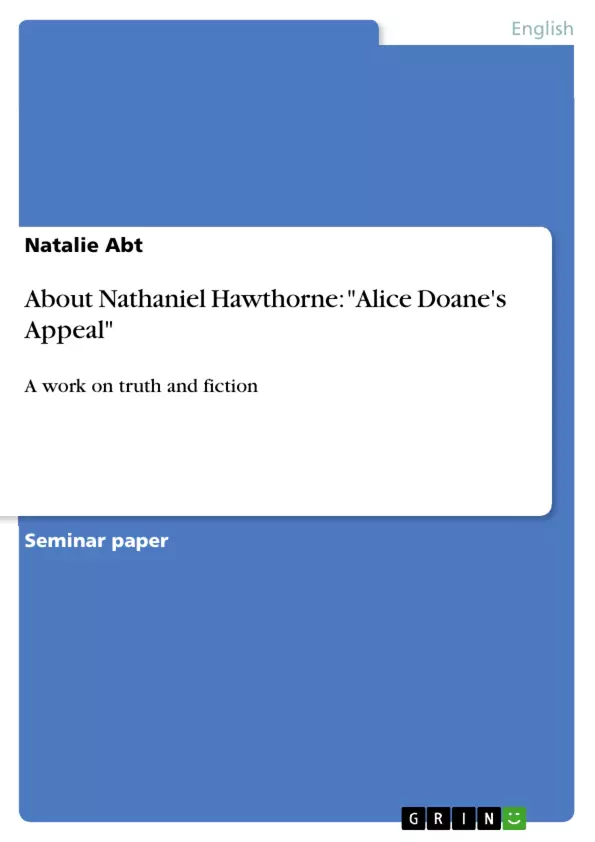I. Introduction
A short story, as Edgar Allan Poe defined it, has to fulfil certain criteria to satisfy both readership and critics. These criteria refer firstly to the length, meaning that the reader must be able to read it in one session. The second requirement is to achieve a unified effect on the reader. This effect ought to create certain emotions and feelings, and through these the reader learns the intention of the author.[1]
On first sight Nathaniel Hawthorne’s storyAlice Doane’s Appealseems to go beyond the scope of Poe’s theory. Considering the fact that the story is not even a single tale with one time, few characters and one intention, it would be easy to say that there can never be a “unity of effect or impression”[2], because the story has a cluttered content.
It consists of two different tales, which have in common only the setting, the narrator and in few aspects, the theme. Both are of about the same length, but are clearly differentiated by a distance of time. One part contains the tale of Alice Doane and her brothers and turns out as being pure fiction. The other tale is about the narrator’s telling of this story to two girls and their reaction to it[3]. Also important to mention is the short fictitious description of a historical event, a procession of accused witches, that took place on the same location as the two other stories.
The story about Alice Doane seems to be the most important part, considering that her name is part of the title. But on closer look, the author himself expresses the intended meaning of the whole story: It describes the “trial whether truth were more powerful than fiction”[4]. In this respect this interpretation wants to show thatAlice Doane’s Appealdoes completely fulfil Poe’s criteria, but in a very special way. The unity of effect that is so important in Poe’s theory refers to the response of the reader.
To analyse this response is Hawthorne’s intention in the story; so it seems only natural that he integrated the reader’s reaction into his tale. Or, to say it more precisely, he put the second story around the first and gave it a chronological order. Alice Doane’s Appealis the test (or proof) which way of telling is best to evoke the desired effects in the audience. Hawthorne uses firstly a fantastic story, describes the reaction of the girls and then sketches a real event. At the end there is the realization that no man can ever create such horrible stories as history has produced. To evoke real, deep and lasting emotions in the audience, a writer must choose his topic from history and reality.
To comprehend Hawthorne’s intention, the modus operandi and his conclusion, this interpretation will be composed in a similar order to the short story itself:
The beginning will be about the role of author and narrator and his motifs. Firstly, his motifs for dividing one short story into three smaller parts., and secondly, for telling his companions a story just in the way he did. After this exposition comes the first of the inner tales: The relationship between Alice and her two brothers, marked by the mutual hatred of the men and their love to Alice. At the same time further family problems are revealed which have to do with past times and past generations. And especially the descriptions of these scenes carry Gothic features. In elaborating on Gothic characteristics it becomes obvious that the author places special emphasis on the atmosphere. The themes of family and atmosphere are also important in the second inner tale, the historical procession of witches. Then finally, in comparison of both tales, it can be examined whether the author was successful, whether he caused the intended reaction in his audience and how he expresses his conclusion.
To start chronologically, the author’s own comments on narration and narrator in the frame tale are to be analysed.



